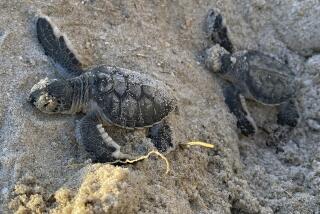Malaysia Sticks Its Neck Out for Turtles
- Share via
RANTAU ABANG, Malaysia — Guided by some unexplained instinct, giant leatherback turtles have been coming to the sandy beaches of this small village on the South China Sea every year for thousands of years to lay their eggs.
But officials are concerned because their numbers are declining.
“These ancient reptiles are greatly endangered, and their landings have dwindled to about 500 per year compared to about 1,800 in 1956,” said one government conservation official.
To prevent the turtles from becoming extinct, the Trengganu state government, Malaysia’s Fisheries Department and the World Wildlife Fund established a special hatchery in Rantau Abang in 1961.
50,000 Eggs Sought
“Our target is to collect 50,000 eggs each year from the beaches, but last year we were able to collect only 30,000 eggs for the hatchery because there were not enough available,” the official said.
The collected eggs are buried in special areas protected by barbed wire. When the eggs hatch about 55 days later, the baby turtles crawl out of the holes and are then released into the sea.
Officials say the hatchery has released about 450,000 turtles since 1961, but many of them are eaten by fish or die from other natural causes. Only about one out of every 1,000 makes it to adulthood.
The turtles, black in color with white and gray patches on their leathery shells, are thought to go back at least 150 million years--to the age of the dinosaurs. Some live as long as 100 years.
Range to Australia, Japan
After roaming as far as Japan, the Philippines and Australia, the giant turtles return to the same shore here where they were born to lay their eggs, making them “scientific wonders,” according to experts at Malaysia’s Agriculture University.
The leatherbacks, scientifically known as Dermochelys coriacea , are the biggest turtles in the world. Adults weigh 700 to 1,300 pounds and average more than 5 feet in length.
In addition to Rantau Abang, the turtles are found in French Guiana, Suriname, Mexico and Indonesia.
The turtles nest five to nine times from July to September, laying nine to 14 white eggs each time. The eggs are soft-shelled, round and a little smaller than tennis balls.
The Malaysian government has given contracts to people to collect the eggs from the beach and pays the equivalent of about 50 cents each for them.
Tourist Attraction
Tourists from as far as the United States, Japan and Europe flock to the 13 miles of beach to watch the turtles at nesting time. However, not everyone is lucky enough to see the creatures crawl slowly out of the sea, dig a hole with their front flippers, turn around, lay their eggs in the hole, cover it with sand with their back flippers and then return to the sea about an hour later.
“I’ve come here to see the turtles many times, but succeeded only on the seventh time,” said Veronica Retnam, a resident here for the last four years.
Narayanan Srinivasan said he has driven the 275 miles from Kuala Lumpur, Malaysia’s capital, several times but has yet to see the giant turtles, which reportedly lay their eggs only at night.
When a turtle appears, guides on motorcycles rush along the beach telling people. But often by the time visitors arrive, the turtle has gone.
Khir Johari, president of the Malaysia branch of the World Wildlife Fund, cautions tourists to stay away from the turtles.
“The poor turtles are harassed and virtually tortured with sticks and lights,” he said. “Some people even think it is funny to climb on their backs. . . . It would be to our everlasting shame if the leatherbacks go extinct.”
More to Read
Sign up for Essential California
The most important California stories and recommendations in your inbox every morning.
You may occasionally receive promotional content from the Los Angeles Times.













